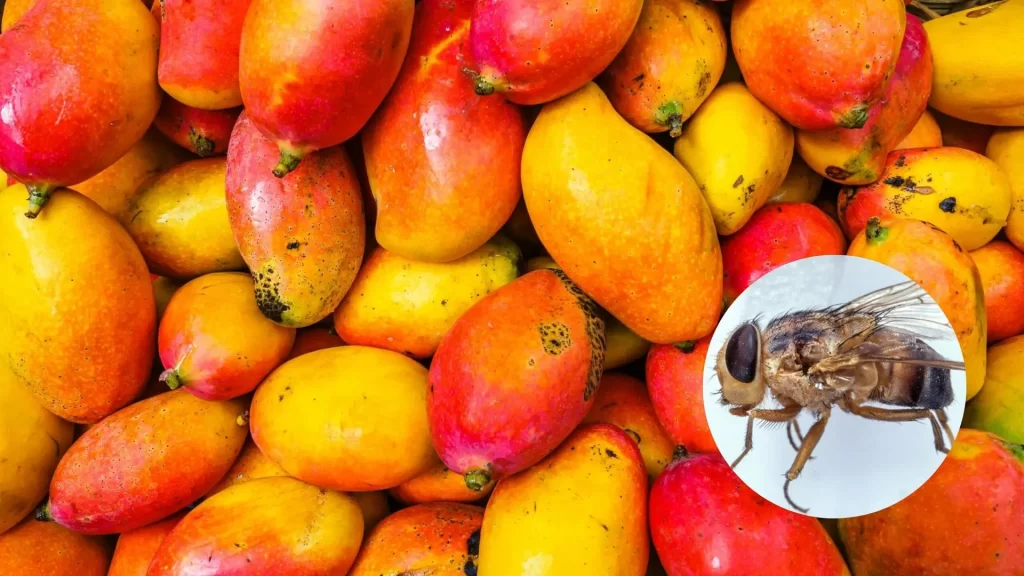
As temperatures continue to rise due to the impacts of climate change, Kenya’s valuable mango crops face a formidable threat from growing pest numbers. Among the country’s most troublesome adversaries for mango farmers is the mango fruit fly, whose presence has become increasingly menacing.
This tiny but destructive insect strategically targets mango trees during their crucial fruiting season, resulting in substantial losses for farmers, with nearly half of their produce being compromised per harvest.
The female fruit fly’s work involves inflicting damage by laying eggs beneath the mango skin, and upon hatching, the larvae tunnel through the fruit, causing it to rot and rendering it unmarketable.
The recurring annual surge in mango fruit fly populations adds to the concern, exacerbating farmers’ challenges in safeguarding their valuable crops.
Detecting Fruit Fly Infestation: Signs and Symptoms to Look Out For
When Mango fruits are infested with fruit flies, there are visible signs. The signs are:
- The fruit appears to have a hole in it.
- The fruit appears soft, and the affected part is discolored; it may be brown or darker than other healthier parts.
- The fruit also appears soft and feels soft when pressed. Sometimes one may mistake it for being ripe while, in the real sense, it’s rotten and falls off the tree with time.
Controlling the Mango Fruit Fly: Effective Management Strategies
Organic methods:
Organic methods are environmentally friendly and they include: trapping, intercropping, natural predators, and organic insecticides.
Trapping: Trapping is capturing and confining specific target insects for pest control.
How to set up a pheromone trap
A pheromone is a chemical substance, like a scent, that the female fruit fly produces to signal other individuals of the same species to engage in certain behavior, such as mating. Some synthetic hormones mimic the natural pheromones of female fruit flies to attract males. Pheromone traps can also monitor fruit fly populations and also detect early infestation.
Materials: Clean, empty plastic bottle (e.g., soda bottle), Scissors or a sharp knife, Pheromone lure or attractant (available online or at garden supply stores), Tape or rubber bands, Liquid or gel attractant, Plastic wrap or funnel.
Procedure:
- Select a plastic bottle that works well for this purpose.
- Cut a small entry near the top of the bottle using scissors or a sharp knife. Ensure the hole is big enough for the fruit fly to enter but not too big to let it out.
- Add a pheromone lure. Place a small amount of Pheromone lure on a cotton ball and attach it to a piece of tape inside the bottle near the entry hole.
- Add gel or liquid attraction to enhance attraction, e.g., apple cider or sugary juice.
- You can also create a funnel to guide the Fruit flies.
- Position the trap in areas where you have observed fruit fly activities.
- Monitor the trap and clear it occasionally after it has captured the fruit flies.
Watch this video to learn more
Intercropping:
Intercropping, or mixed cropping, refers to growing two or more crops simultaneously in the same field. The main idea behind intercropping is to maximize the efficient use of available resources, such as sunlight, water, and nutrients, by creating a mutually beneficial interaction between the crops. Planting mango trees with other crops attracts the fruit fly so that the fly is attracted to the alternative crop instead of the mango crop.
Natural Predators:
Natural predators prey on other organisms by killing and feeding on them, keeping their population in check. Insects like ladybirds and lacewings feed on the fruit fly eggs reducing their population.
Organic insecticides
Organic pesticides are substances derived from natural sources that control pests and manage plant diseases in organic farming and gardening practices. These pesticides are majorly derived from plant extracts. They are considered a more environmentally friendly alternative to synthetic chemical pesticides commonly used in conventional agriculture. Examples include neem oil, world sunflower, and pyrethrin derived from plants, which can be used to spray and control mango fruit flies.
How to make organic insecticides
- Collect of green leaves of the preferred herb or plant detached from the midrib in a bucket and add water
- Pound the leaves in a mortar and soak overnight or 12 hrs
- Collect the leaves and squeeze out the liquid
- Strain the liquid through a kitchen sieve or muslin cloth to remove leaf pieces
- Add some soap into a small amount of water until dissolved
You can use the liquid from the leaves for up to one week after preparation, but storing it in a cool, dark place is best.
Chemical methods:
Using insecticides:
Insecticides are chemical substances designed to target and eliminate insect pests, which can cause damage to crops or transmit diseases.
Insecticides such as malathion, methomyl, and carbaryl can kill fruit flies. However, these should be applied according to labeled instructions, and care should be taken to avoid harming useful insects. You can get insecticides from your nearest licensed agro-vet.
Cultural methods:
These methods include;
- Collecting fallen fruit promptly and treating the soil regularly with organic pesticides.
- Use of a fruit-based lure, such as fermented fruit or vinegar, that attracts the fruit fly
- Farmers also try to pick their fruit as soon as it is ripe to shorten the time it can attract fruit flies.
- Good orchard sanitation can help disrupt the fruit fly’s life cycle.
The control of the mango fruit fly is vital to ensure the productivity and profitability of mango orchards. By combining cultural control methods, targeted chemical applications, and biological control strategies, farmers can effectively manage this pest, protecting their harvests and delivering high-quality mangoes to consumers.
